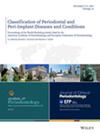Multiscale, interspecies evaluation of parameters affecting alveolar bone repair.
IF 3.8
2区 医学
Q1 DENTISTRY, ORAL SURGERY & MEDICINE
引用次数: 0
Abstract
BACKGROUND We undertook a comparative analysis of bone healing in the craniomaxillofacial (CMF) skeleton, focusing on the extent to which the physiological processes of bone repair and remodeling differed between different species. Understanding these differences can enhance the value of research outputs and thus improve treatment strategies. METHODS An osteotomy was produced in an equivalent anatomical location in mice, rats, minipigs, and human patients. Quantitative analyses were performed using micro-computed tomographic (µCT) imaging, histology, dynamic histomorphometry, immunohistochemistry, and cellular activity assays. RESULTS Non-invasive imaging analyses, histomorphometry, and molecular and cellular analyses together demonstrated that the overall bone repair program was highly conserved between rodents and minipigs, correlating with limited human data. Comparing the rate of bone repair across species was confounded by limited time points for analysis in human tissues. However, at later time points, CMF bone repair in minipigs was equivalent to CMF bone repair in rodents. CONCLUSIONS The molecular and cellular features of bone repair are shared among large and small animals, suggesting a common bone healing mechanism among species. Combined with the availability of transgenic lines and an extensive array of molecular and cellular analyses, this makes rodents an appealing choice for preclinical testing. PLAIN LANGUAGE SUMMARY We conducted this study to understand how bone heals in the head skeleton. We compared this repair process in animal models, including mice, rats, and minipigs, against a limited set of data from humans. Our goal was to determine whether bone repair and remodeling were conserved between species because this would have implications for preclinical studies to improve treatment strategies. We created a controlled injury in similar bone areas in each species, then examined the healing process using various research techniques, analyzing bone architecture and cellular activity. Our findings showed that the overall process of bone healing was similar between species. Although we had limited data from humans at later stages of healing, the healing patterns in minipigs closely matched those in rodents at the later stages. These similarities suggest that the way bones heal is equivalent among mammals. Therefore, with the added advantage of advanced research techniques available, rodents are an excellent choice for testing new treatments before advancing to studies in large animals and testing in humans.影响牙槽骨修复的多尺度、物种间参数评估。
背景:我们对颅颌面(CMF)骨骼的骨愈合进行了比较分析,重点关注不同物种之间骨修复和重塑的生理过程的差异程度。了解这些差异可以提高研究成果的价值,从而改进治疗策略。方法在小鼠、大鼠、小型猪和人类患者的相同解剖位置进行截骨术。采用显微计算机断层扫描(µCT)成像、组织学、动态组织形态学、免疫组织化学和细胞活性测定进行定量分析。结果非侵入性影像学分析、组织形态学分析、分子和细胞分析共同表明,啮齿动物和小型猪的整体骨修复程序高度保守,与有限的人类数据相关。比较不同物种间的骨修复率受到人体组织分析的有限时间点的限制。然而,在较晚的时间点,迷你猪的CMF骨修复与啮齿动物的CMF骨修复相当。结论大、小型动物的骨修复具有相同的分子和细胞特征,表明物种间存在共同的骨修复机制。结合转基因品系的可用性和广泛的分子和细胞分析,这使得啮齿动物成为临床前试验的一个有吸引力的选择。我们进行这项研究是为了了解骨骼如何在头部骨骼中愈合。我们将小鼠、大鼠和迷你猪等动物模型中的修复过程与人类的有限数据进行了比较。我们的目标是确定骨修复和重塑是否在物种之间是保守的,因为这将对临床前研究改善治疗策略有意义。我们在每个物种的相似骨骼区域创建了一个受控损伤,然后使用各种研究技术检查愈合过程,分析骨骼结构和细胞活动。我们的研究结果表明,骨愈合的整体过程在物种之间是相似的。虽然我们在人类愈合后期的数据有限,但迷你猪的愈合模式与啮齿动物的愈合后期非常吻合。这些相似之处表明,哺乳动物的骨骼愈合方式是相同的。因此,随着先进研究技术的增加,在进行大型动物研究和人类试验之前,啮齿动物是测试新疗法的绝佳选择。
本文章由计算机程序翻译,如有差异,请以英文原文为准。
求助全文
约1分钟内获得全文
求助全文
来源期刊

Journal of periodontology
医学-牙科与口腔外科
CiteScore
9.10
自引率
7.00%
发文量
290
审稿时长
3-8 weeks
期刊介绍:
The Journal of Periodontology publishes articles relevant to the science and practice of periodontics and related areas.
 求助内容:
求助内容: 应助结果提醒方式:
应助结果提醒方式:


